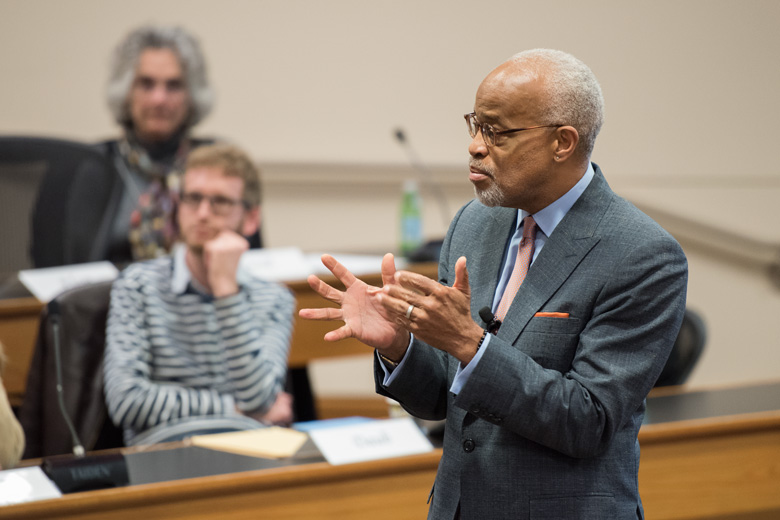Stanford's Faculty Senate discusses shifting educational environment
Harry J. Elam Jr., vice provost for undergraduate education, titled his annual address to the senate "Our Shifting Educational Environment: Why Stanford's Leadership in Higher Education is Critical Now."

Vice Provost for Undergraduate Education Harry J. Elam Jr. addresses the Faculty Senate about the changing circumstances under which undergraduate education operates at Stanford. (Image credit: L.A. Cicero)
In the ecosystem of higher education, three major developments – changing demographics, changing social and emotional norms, and changing educational mindsets – will continue to influence the direction of undergraduate education, Harry J. Elam Jr., vice provost for undergraduate education, told the Faculty Senate yesterday.
Speaking at the Jan. 21 meeting, Elam said the circumstances under which undergraduate education operates at Stanford have changed considerably from those that existed just four years ago, when the university began implementing new programs recommended in the Study of Undergraduate Education at Stanford (SUES).
“As a result, I think it is important not only to update you today on where we are, but to consider where we might go, given this new environment, and to try to understand why it is important that Stanford seize this particular moment to reimagine what undergraduate education can be,” said Elam, who also is a professor of theater and performance studies at Stanford.
Elam outlined four critical domains of action: transforming the pivotal freshman and sophomore years; expanding experiential learning; reaffirming the importance of residential education; and reclaiming liberal education.
Following the SUES mandate, Stanford has implemented new programs in those domains, including Thinking Matters, a new requirement for freshmen instituted in autumn 2012; Stanford in New York, which began in autumn 2015; Cardinal Service, which launched in September 2015; Humanities at Manzanita Park, which welcomed its first cohort of student residents in September 2015; and Ways of Thinking/Ways of Doing, new breadth requirements instituted in autumn 2013.
He said Stanford has made significant efforts in those domains in recent years.
Elam said it is important to understand and embrace the “whole” of the student experience at Stanford, both inside and outside the classroom.
“A concern for the whole student means faculty working to engage our students as co-creators of knowledge and meaning for their education,” he said.
Elam cited several examples of Stanford programs and initiatives that address the whole student, including global programs at Stanford Graduate School of Business and Stanford Law School that enable students to learn in multiple spheres and to develop as world citizens and leaders, as well as residential initiatives in theme dorms that integrate the cultural, intellectual, social and academic experiences of students.
In outlining his vision of the future, Elam posed several questions:
- How do we truly take advantage of our geographic position on the Pacific Rim to become even more a global university?
- How do we create new synergies that reach out to students in their residences and structure new social engagements?
- How can we create strategies to deal more effectively with the issues of student health and wellbeing, which intersect everything that happens on campus?
- What do we want the academic major to accomplish in today’s environment?
- How can we put together seemingly disparate fields and issues into new informative conversations?
- How can we integrate our strengths in digital media and visual communication?
- How can we energize and maximize the demand for data science problem solving across disciplines?
- How can we make diversity a fundamental part of our intellectual project?
“As we continue to evolve and nurture spaces that are both dynamic and creative, new harmonies and a new integrative vision of undergraduate education will emerge,” he said.
The full minutes of the Jan. 21 senate meeting will be available soon on the Faculty Senate website. The minutes will include the question-and-answer session that followed Elam’s presentation.
